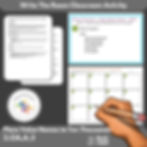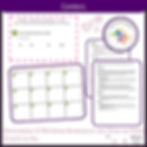Do you ever wonder how we can better support students with disabilities in developing their math skills? The secret lies in individualized education programs (IEPs) and word problem IEP goals specifically designed to empower these students. By setting tailored, achievable goals and implementing effective strategies, we can help special education students unlock their potential and thrive in the world of mathematics.
In this blog post, we’ll explore the importance of word problem skills, the components of effective word problem IEP goals, various teaching strategies, sample goals for different math operations, and how to adapt these goals for students of different age groups and reading abilities. So, let’s dive into the world of IEP goals and word problems to help students succeed in math!
Key Takeaways
Create SMART goals with measurable criteria to boost math skills in special ed
Use visual supports, breaking down problems into smaller steps & reinforcing keywords/vocabulary for effective teaching of word problems
Monitor progress and adjust IEP goals regularly for best support of student growth
Developing IEP Goals for Word Problems

Individualized Education Programs (IEPs) are instrumental in addressing the distinct needs of students with disabilities. These customized plans set specific goals and provide accommodations that enable students to improve their math skills and independently determine solutions to problems. Creating successful IEP goals for word problems involves strategies like one to one correspondence to help students comprehend the relationship between numbers and items in the problems.
Setting clear goals boosts a student’s capacity to identify key information, apply accurate mathematical operations, and refine problem-solving skills. Let’s look closer at the importance of word problem skills and the components of effective IEP goals.
Importance of Word Problem Skills
Proficient word problem-solving skills are pivotal for success in academics, professional life, and practical applications. Teaching students to solve word problems effectively aids in developing their critical thinking and problem-solving skills, beneficial in diverse life aspects. Furthermore, working on word problems helps students strengthen their executive functioning skills, such as working memory and cognitive flexibility.
To help special education students grasp keyword vocabulary, teachers can clearly explain the words and their meanings, as well as provide practical examples of word problems that involve these keywords. This focused approach can help students achieve their math goals and improve their overall understanding of word problems.
Components of Effective IEP Goals
An effective IEP goal should be SMART:
Specific: Delineate the desired outcome, success criteria, and completion timeframe
Measurable: Enable effective planning, monitoring, and evaluation of the student’s progress
Achievable: Realistic and attainable for the student
Relevant: Address the student’s specific needs and areas of growth
Time-bound: Have a clear completion timeframe
This clarity and focus enable us to effectively plan, monitor, and evaluate the student’s progress.
Assessing progress is integral to the success of an IEP goal. A student’s performance can be measured quarterly, allowing the IEP team to make adjustments and provide additional support as needed. Setting measurable goals heightens accountability and student engagement, fostering overall academic success.
Strategies for Teaching Word Problems in Special Education

Various teaching strategies can support special education students in understanding and solving word problems. These strategies include using visual supports, breaking down problems into smaller steps, and reinforcing keywords and vocabulary. Implementing these techniques helps provide the requisite support for students to excel in their mathematical word problem skills.
Let’s dive deeper into these strategies and explore how they can be effectively applied in the classroom.
Visual Supports
Visual aids like graphic organizers and manipulatives can considerably augment a student’s grasp of word problems. Number lines, Cuisenaire rods, and place value charts are just a few examples of math manipulatives that can be used with graphic organizers to help students visualize and solve word problems.
Visual supports can also be particularly helpful for students who struggle with reading comprehension or have difficulty processing verbal information. Diagrams, charts, or pictures can make the problem more concrete and easier to understand. They can also help students organize information and identify key details in the problem, increasing engagement and motivation.
Breaking Down Problems into Smaller Steps
Segmenting word problems into smaller steps can enhance comprehension, reduce cognitive load, refine problem-solving skills, and foster confidence for students in special education. To break down word problems into smaller steps, it’s crucial to visualize the problem, break it into smaller components, and then guide students through each step.
Using a variety of teaching techniques can prove effective in helping special education students break down word problems. Some techniques to consider are:
Solving word problems regularly
Teaching problem-solving routines
Visualizing or modeling the problem
Providing clear and concise models
By incorporating these techniques into your teaching, you can support special education students in understanding and solving word problems more effectively.
Reinforcing Keywords and Vocabulary
Imparting and reinforcing keyword vocabulary is vital in aiding students to comprehend word problems better. By recognizing key words and phrases that indicate mathematical operations and relationships, students can apply the right problem-solving strategies and improve their comprehension of word problems.
Some effective techniques for reinforcing keywords and vocabulary in special education include:
Using keyword vocabulary
Training students to paraphrase relevant information
The keyword method
Word walls or graphic organizers
Keep in mind that solely relying on keywords could limit conceptual understanding, so it’s essential to incorporate other teaching strategies as well.
Sample IEP Goals for Different Math Operations

To enhance support for special education students in solving word problems, we should consider sample IEP goals for different mathematical operations, like:
Addition Word Problem IEP Goal
A sample goal for solving one-step addition word problems could be: “Given a one-step addition word problem (single digit, double-digit, etc.), the student will independently solve the problem with 80% accuracy on 4 out of 5 trials.” For multi step word problem scenarios, you might aim for: “Given a multi-step addition word problem, the student will independently solve the problem with 75% accuracy on 4 out of 5 trials.”
These goals encourage students to develop a deeper understanding of the addition process while also addressing their individual needs in solving word problems. By setting specific accuracy rates and timeframes, we can better track progress and make necessary adjustments to the goals.
Example Addition Word Problem IEP Goals
1.OA.A.1: Use addition and subtraction within 20 to solve word problems involving situations of adding to, taking from, putting together, taking apart, and comparing, with unknowns in all positions, e.g., by using objects, drawings, and equations with a symbol for the unknown number to represent the problem. This goal covers the following objectives
Solve addition word problems with pictures
Scaffolded addition word problems with sums up to 10
Solve addition word problems with sums up to 20
Write an addition sentence that fits the story (two-digit numbers)
Grade Level Standard: 1.OA.A.2: Solve word problems that call for addition of three whole numbers whose sum is less than or equal to 20, e.g., by using objects, drawings, and equations with a symbol for the unknown number to represent the problem. This goal covers the following objectives
Add three numbers - word problems
Solve addition word problems with sums up to 20
Solve addition facts - sums up to 20
Solve addition word problems - sums up to 10
Subtraction Word Problem IEP Goal
A sample goal for solving subtraction word problems might be: “Given a subtraction word problem, the student will independently solve the problem using appropriate subtraction strategies with 80% accuracy, in 4 out of 5 opportunities, by the end of the IEP period.” This goal focuses on the student’s ability to apply subtraction strategies effectively and accurately in solving word problems.
Setting a specific accuracy rate and timeframe allows us to monitor the student’s progress and make any necessary adjustments to the goal. Remember to keep the goal SMART:
Specific
Measurable
Achievable
Relevant
Time-bound
Example Subtraction Word Problem IEP Goals 2.OA.A: Represent and solve problems involving addition and subtraction.
2.OA.A.1: Use addition and subtraction within 100 to solve one- and two-step word problems involving situations of adding to, taking from, putting together, taking apart, and comparing with unknowns in all positions, e.g., by using drawings and equations with a symbol for the unknown number to represent the problem. This goal covers the following objectives
Solve two-step addition and subtraction word problems - up to 100
Add and subtract word problems - up to 100
Add and subtract word problems - up to 20
Add three numbers up to two digits each: word problems
Multiplication and Division Word Problem IEP Goal
For multiplication word problems, a sample goal could be: “Given a word problem that requires multiplication, the student will solve the problem and find the product with 80% accuracy on 4 out of 5 trials.”
As for division word problems, a goal might look like this: “Given a division word problem, the student will independently solve the problem using appropriate division strategies with 80% accuracy, in 4 out of 5 opportunities, by the end of the IEP period.”
These goals focus on the student’s ability to apply multiplication and division strategies effectively and accurately in solving word problems. By setting specific accuracy rates and timeframes, we can track progress and make any necessary adjustments to the goals.
Example Multiplication and Division Word Problem IEP Goals
3.OA.A.3: Use multiplication and division within 100 to solve word problems in situations involving equal groups, arrays, and measurement quantities, e.g., by using drawings and equations with a symbol for the unknown number to represent the problem. This goal covers the following objectives
Write variable equations to represent word problems: multiplication and division only
Multiplication and division word problems
Division word problems
Multiplication word problems
These goals can serve as a guide for writing more specific individualized IEP goals that cater to the unique needs of each student.
Bear in mind, personalizing the IEP goal to cater to each special education student’s individual needs is imperative. With that in mind, let’s explore some sample goals for each math operation.
Adapting Word Problem IEP Goals for Different Age Groups

As students advance in their education, their IEP goals for word problems should adapt to accommodate their evolving needs and abilities. In this section, we’ll discuss how to adapt IEP goals for different age groups, such as elementary, middle, and high school students.
Taking into account the distinct needs of students at each educational stage, we can formulate effective and age-appropriate IEP goals that bolster their growth and development in mathematical word problem skills.
Elementary School
For elementary school students, IEP goals for word problems should focus on building a solid foundation in math skills and problem-solving strategies. Some ways to adapt IEP word problems for this age group include:
Simplifying the language and concepts
Using visual aids and manipulatives
Providing step-by-step guidance
Incorporating real-life examples and familiar contexts
These strategies can help students solve word problems better and enhance their understanding.
By setting age-appropriate goals and providing the necessary support, we can help elementary school students develop a strong foundation in word problem skills, setting them up for success as they progress through their education.
Middle School
Middle school students need IEP goals that build on their elementary math skills and delve deeper into more advanced concepts. To adapt IEP goals for this age group, consider:
Increasing the complexity of word problems
Incorporating higher-order thinking skills
Setting up multi-step problems
Providing scaffolding and support
By challenging middle school students with more complex word problems and offering various problem-solving strategies, we can help them develop the skills necessary for success in high school and beyond.
High School
High school students require IEP goals that prepare them for post-secondary education and employment. These goals should focus on analyzing and interpreting data, applying advanced algebraic concepts, and solving multi-step equations. To adapt IEP goals for high school students, give them a clear and concise model of how to solve word problems and ensure ample practice and reinforcement.
By tailoring IEP goals to the unique needs and abilities of high school students, we can help them develop the advanced problem-solving skills necessary for success in their future endeavors.
Monitoring Progress and Adjusting IEP Goals

Tracking progress and modifying IEP goals is imperative to ensure students’ continuous growth and development in their math word problem skills. By regularly assessing student progress, we can make data-driven decisions about instruction and interventions, pinpoint areas of strength and improvement, and make necessary adjustments to IEP goals.
In the next two subsections, we will explore methods for measuring student progress and adjusting IEP goals based on their evolving needs.
Measuring Progress
Tracking student progress toward IEP goals can be accomplished through different methods like:
Direct observation
Tests
Assessments
IEP Goal Data Sheets
We should check in on progress towards IEP goals at least every two weeks, but it could be more or less often depending on the goal.
Data analysis plays a crucial role in tracking IEP goals. It helps us:
Identify areas of strength and improvement
Make informed decisions about instruction and interventions
Provide objective evidence of a student’s progress
Adjusting Goals
Modifying IEP goals is vital to ensure continuous progress in students’ word problem skills. If a student isn’t making the appropriate progress or is losing skills they previously had, it may be time to adjust their IEP goal. We should review the IEP annually to ensure that the goals are still suitable for the student.
When adjusting IEP goals for word problems, it’s important to consider the student’s individual needs and progress, as well as any specific challenges they may be facing. By regularly monitoring progress and making necessary adjustments, we can provide the best possible support for our students’ growth in math word problem skills.
Summary
In this blog post, we explored the importance of setting IEP goals for word problems to help special education students develop their math skills. We discussed various teaching strategies, such as visual supports, breaking down problems into smaller steps, and reinforcing keyword vocabulary. We also provided sample IEP goals for different math operations and tips for adapting goals to different age groups.
Empowering special education students with the right tools and support can make all the difference in their success in mathematics. By setting individualized, achievable goals and implementing effective strategies, we can help them unlock their potential and thrive in the world of math word problems.
Frequently Asked Questions
What are the IEP goals examples?
IEP goals examples range from improving reading comprehension and fluency to developing self-regulation, communication and organizational skills. They may also include honing math skills, fine motor control, social skills and college/career exploration.
What are the IEP goals for letter word identification?
The IEP goal for letter word identification is that the student will correctly identify and verbally name 3 lowercase letters during each session with 80% accuracy across three consecutive data collection points.
What are the IEP writing goals for grammar?
Writing goals for grammar should include complete sentences with proper syntax, sentence variety, subject-verb agreement, punctuation, and capitalization.
What is the significance of IEP goals for word problems?
IEP goals for word problems provide special education students with objectives and accommodations to help them learn math independently and develop their problem-solving skills.
What are some effective strategies for teaching word problems in special education?
Using visual supports, breaking down word problems into smaller steps, and reinforcing keyword vocabulary are effective strategies for teaching word problems in special education.
































